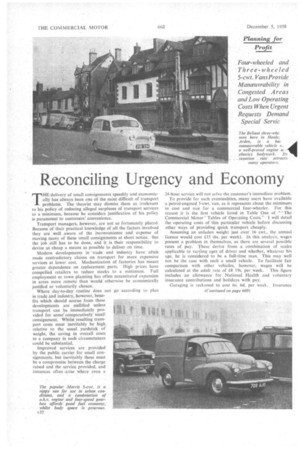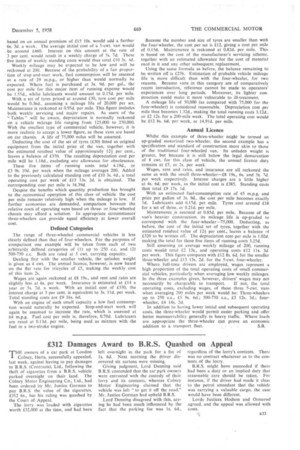Reconciling Urgency and Economy
Page 76

Page 83

If you've noticed an error in this article please click here to report it so we can fix it.
THE delivery of small consignments speedily and economically has always been one of the most difficult of transport problems. The theorist may dismiss them as irrelevant to his policy of reducing alleged surpluses of transport services to a minimum, because he considers justification of his policy is paramount to customers' convenience.
Transport managers, however, are not so fortunately placed. Because of their practical knowledge of all the factors involved they are well .aware of the inconvenience and expense of moving many of these small consignments at short notice. But the job still has to be done, and it is their responsibility to devise as cheap a means as possible to deliver on time.
Modern developments in 'trade and industry have ofteh made contradictory claims on transport for more expensive services at lower cost. Mechanization of factories has meant greater dependence on replacement parts. High prices have compelled retailers to reduce stocks to a minimum. Full employment or town planning has often necessitated expansion in areas more remote than would otherwise be economically justified or voluntarily chosen.
Where day-to-day routine does not go according to plan in trade and industry, however, benefits which should accrue from these developments are nullified unless transport can be immediately provided for some/ comparatively small consignment. Whilst resulting transport costs must inevitably be high, relative to the usual yardstick of weight, the saving in overall costs to a company in such circumstances could be substantial.
Improved services are provided by the public carrier for small consignments, but inevitably these must be a compromise between the charge raised and the service provided, and instances often arise where even a 24-hour service will not solve the customer's immediate problem.
To provide for such eventualities, many users have available a petrol-engined 5-cwt. van, as it represents about the minimum in cost and size for a commercial four-wheeler. For this reason it is the first vehicle listed in Table One of "'The Commercial Motor' Tables of Operating Costs." I will detail the operating costs of this particular vehicle before discussing other ways of providing quick transport cheaply.
Assuming an unladen weight just over 16 cwt., the annual licence would cost £15 (6s. per week). In this analysis, wages present a problem in themselves, as there are several possible rates of pay. These derive from a combination of scales applicable to van7ing ages of driver and whether, whatever his age, he is considered to be a full-time man. This may well not be the case with such a small vehicle. To facilitate fair comparison with other vehicles, however, wages will be calculated at the adult rate of £8 19s. per week. This figure includes an allowance for National Health and voluntary insurance contributions and holidays with pay.
Garaging is reckoned to cost bs. 6d. per week. Insurance (Continued on page 669) based on an annual premium of £15 10s. would add a further 6s. 3d. a week. The average initial cost of a 5-cwt, van would be around £460. Interest on this amount at the rate of 3 per cent. would result in a weekly charge of 5s. 7d. These five items of weekly standing costs 'would -thus total flO 3s, 4d.
Weekly mileage may be expected to be low and will be reckoned at 200. Because of the probability of a fair proportion of stop and-start work, fuel consumption will be assessed at a rate of 29 m.p.g., or higher than would normally he expected. Where fuel is purchased at 3s. 9d. per gal., the cost per mile for this major item of running expense would be 1.55d., whilst lubricants would amount to 0.15d. per mile.
With, a set of tyres priced at around £30, tyre cost per mile would be 0.36d., assuming a mileage life of 20,000 per set Maintenance is reckoned at 0.95d. per mile, This figure includes both. weekly servicing and major repairs. As users of the " Tables " will be aware, depreciation is normally reckoned on a vehicle mileage life ranging from 125,000 to 250,000, With the smallest type of commercial vehicle, however, it is more realistic to accept a lower figure, as these vans are based on car chassis. A life of 75,000 miles will be assumed.
Deducting the cost of the set of tyres (£30) fitted as original equipment from the initial price of the van, together with the estimated residual value of approximately 121 per cent., leaves a balance of £370. The resulting depreciation cost per mile will be 1.18d., excluding. any allowance for obsolesence.
These five items of running costs total 4.19d., or £3 9s. 10d. per week when the mileage averages 200. Added to the previously calculated standing cost of £10 3s, 4d., a total operating cost per week of £13 13s, 2d. is obtained. The corresponding cost per mile is 16.39d.
Despite the benefits which quantity production has brought to the .economical operation of this class of vehicle, the cost per mile remains relatively high when the mileage is low, If further economies are demanded, comparison between the relative costs of operating vans based on threeor four-wheeled chassis may afford a solution. In appropriate circumstances three-wheelers can provide equal efficiency at lower overall cost.
Defined Categories
The range of three-wheeled commercial vehicles is less clearly defined than that of four-wheelers. For the purposes of comparison one example will be taken from each of two arbitrarily defined categories of (1) up to 250 c.c. and (2) 500-750 c.c. Both are rated at 5 cwt. carrying capacity.
Dealing first with the smaller vehicle, the unladen weight is given as 4 cwt. The annual licence, however, is now based on the flat rate for tricycles of £5, making the weekly cost of this item 2s.
Wages are again reckoned at £8 19s., and rent and rates are slightly less at 6s. per week, Insurance is estimated at £14 a year or 5s. 7d. a week. With an initial cost of £330, the interest charge at 3 per cent. is equivalent to 3s, 11d, per week. Total standing costs are £9 16s. fid.
With an engine of such small capacity a low fuel consumption would naturally be expected. Stop-and-start work will again be assumed to increase the rate, which is assessed at 64 m.p.g. Fuel cost per mile is, therefore, 0.70d. Lubricants are rated at 0.13d. per mile, being used as mixture with the fuel in a two-stroke engine. Because the number and size of tyres are smaller than with the four-wheeler, the cost per set is £12, giving a cost per mile of 0.15d. Maintenance is reckoned at 0.82d. per mile. This is based on the cost of the manufacturer's servicing scheme. together with an estimated allowance for the cost of material used in it and any other subsequent .replacement.
Using the same formula as before, the balance remaining to be written off is £276. Estimation of probable vehicle mileage life is. more difficult than with the four-wheeler, for two reasons. Because vans in this category Are of comparatively recent introduction, reference cannot be made to operators' experiences over long periods. Moreover, its lighter construction could make it more vulnerable to ill-treatment.
A mileage life of 50,000 (as compared with 75,000 for the four-wheeler) is considered reasonable. Depreciation cost per mile thus becomes 1.32d., making the total running costs 3,12d., or £2 12s. for a 200-mile week. The 'total operating cost would be £12 8s. 6d, per week, or .14.91d. per mile.
Annual Licence
Whilst this example of three-wheeler might be termed an up-graded motorized two-wheeler, the second example has a Specification and standard of construction more akin to those of the traditional four-wheeled van. Its unladen weight is greater, but because it is still below the legal demarcation of 8 cwt. for this class of vehicle, the annual licence duty remains at £5, or 2s. per week. • Wages, rent and rates, and insurance are all reckoned the same as with the small three-wheeler-£8 19s., Cs. and 5s. 7d. per week respectively. Interest charges are a little higher at 4s. 6d. per week, as the initial cost is £385. Standing cods thus total £9 17s. Id.
With an estimated fuel-consumption rate of 45 m.p.g. and price per gallon of 3s. 9d., the cost per mite becomes exactly Id. Lubricants add 0.15d. per mile. Tyrescost around £18 for a set of three, or 0.21d. per mile.
Maintenance assessed at 0.85d. per mile. Because of the van's heavier construction, its mileage life is up-graded to correspond with the four-wheeler-75,000. Deducting, as before, the cost of the initial set of tyres, together with the estimated residual value of 12+ per cent.; leaves a balance of £320 to be written off. The depreciation cost-per mile is 1.02d. making the total for these five items of running costs 3.25d.
Still assuming an average weekly mileage of 200, running costs would total £2 13s., and operating costs £12 Hs. 3d. per week. This figure compares with £12 8s. 6d. for the smaller three-wheeler and £13 13s. 2d. for the 5-cwt, four-wheeler.
Where full-time drivers are employed, wages represent a high proportion of the total operating costs of small commercial vehicles, particularly when averaging low weekly mileages. In the three examples given, however, drivers' wages may not
necessarily be chargeable to transport. If not, the total operating costs, excluding wages, of these three -5-cwt. vans when averaging 200 miles per week would be: Three-wheelers up to 250 c.c., 13 9s. 6d.; 500-750 c.c., £3 12s.. 3d.; fourwheeler, £4 14s. 2(1.
In addition to having lower initial and subsequent operating costs, the three-wheeler would permit easier parking and offer better manceuvrability generally in heavy traffic. Where loads are appropriate the three-wheeler, can prove an economic addition to a transport fleet. S.B.
























































































































